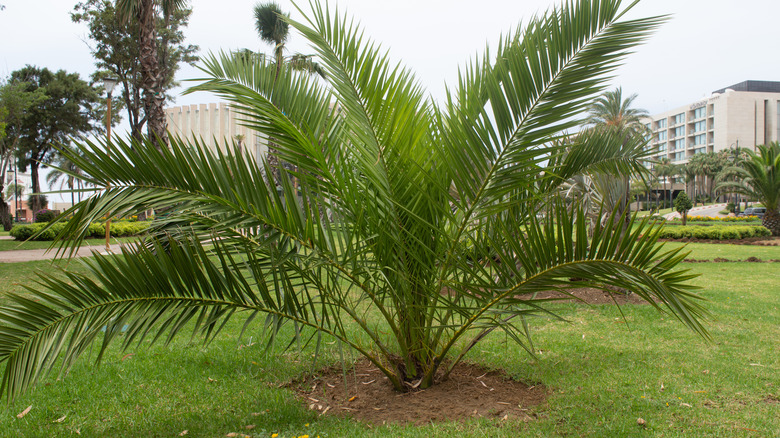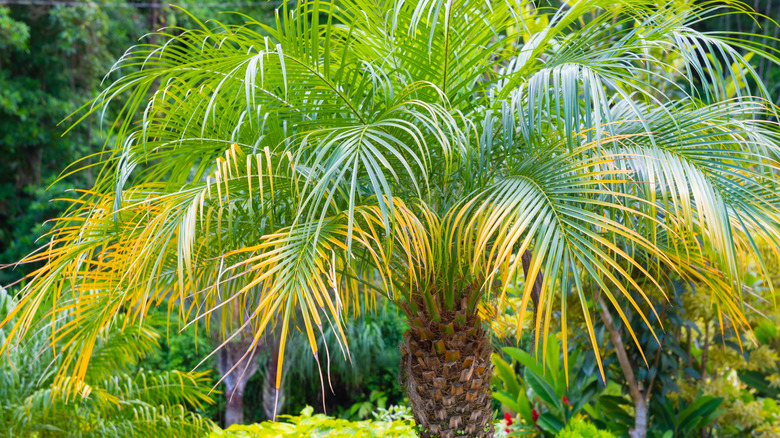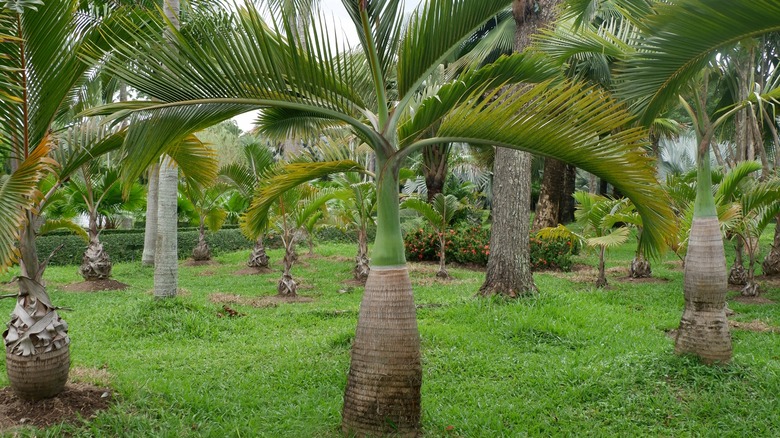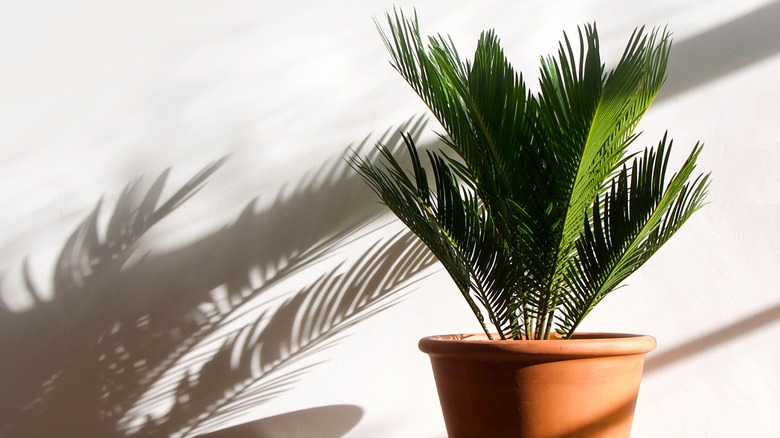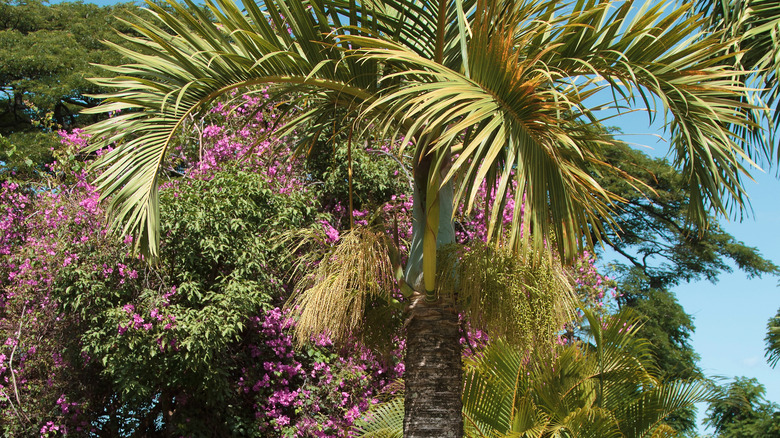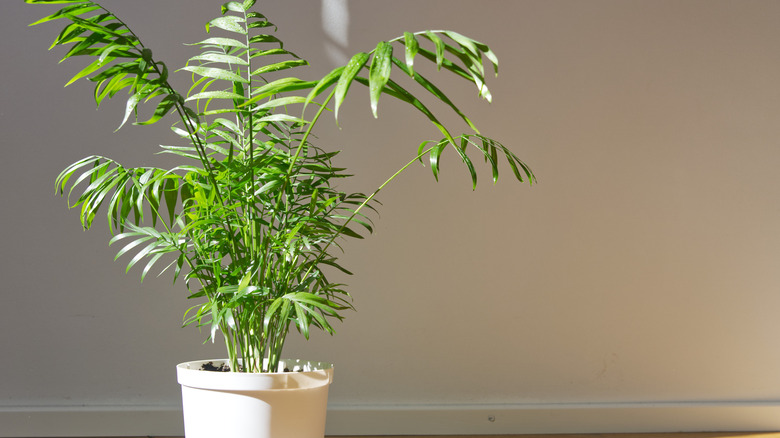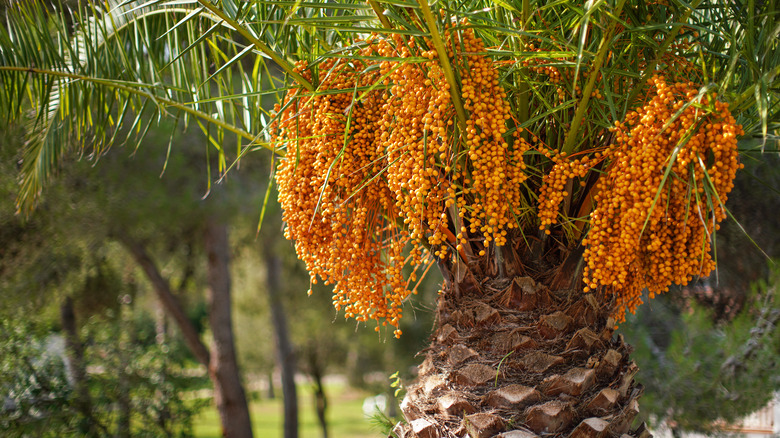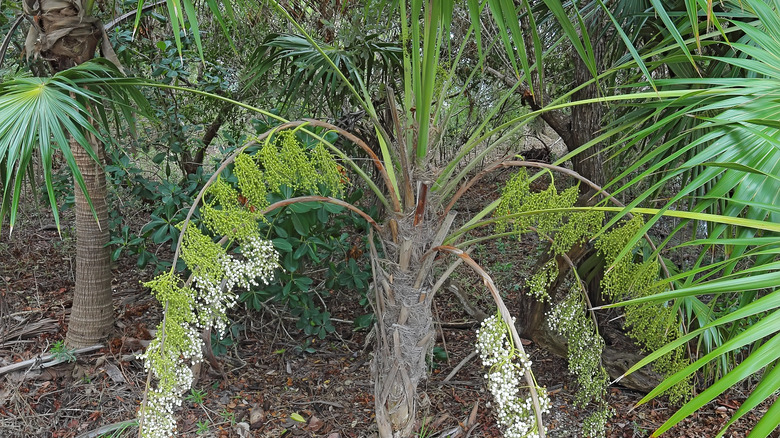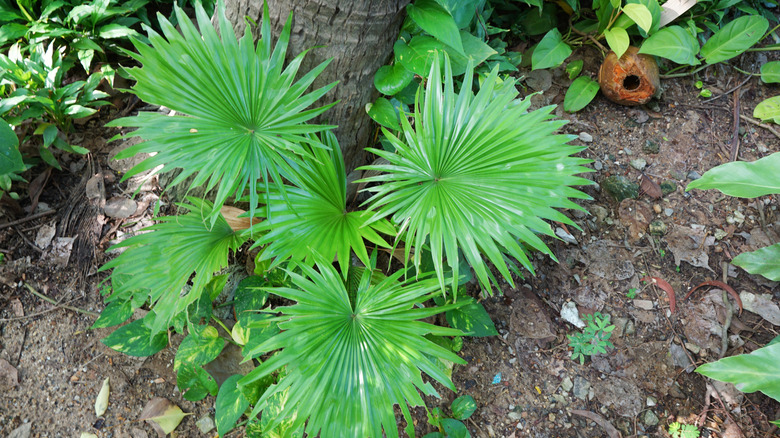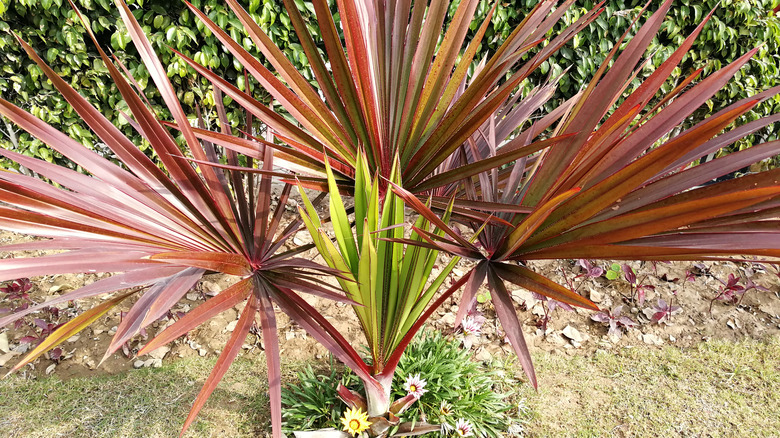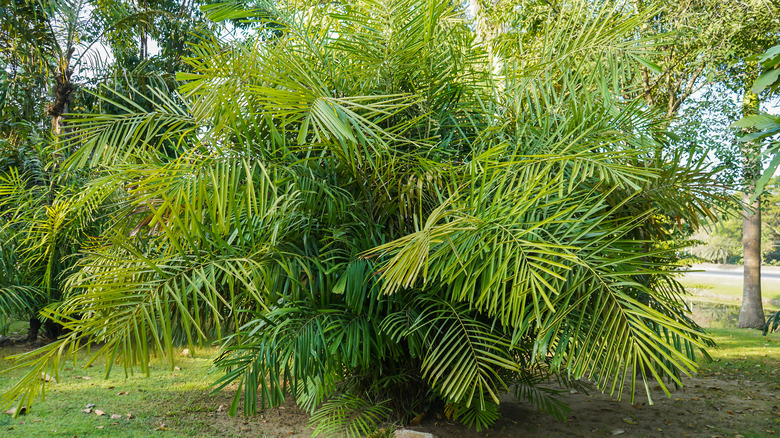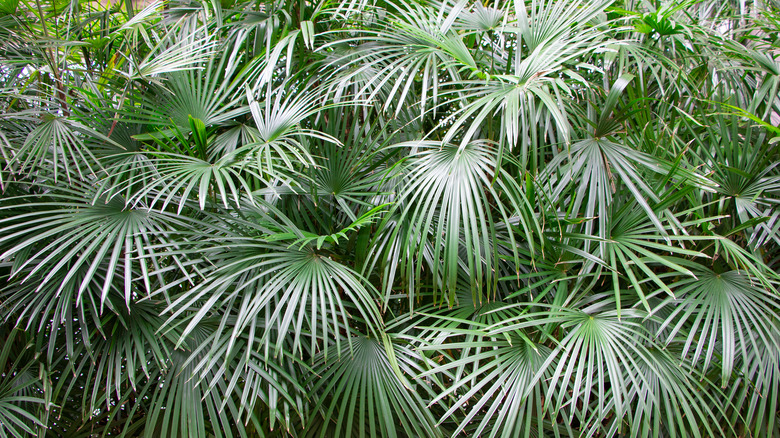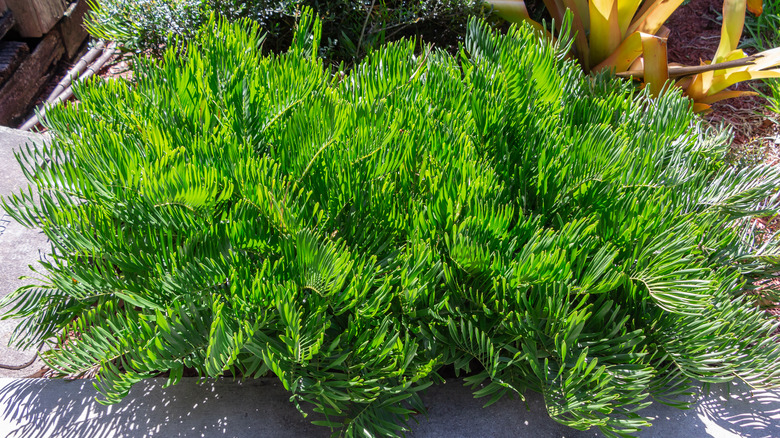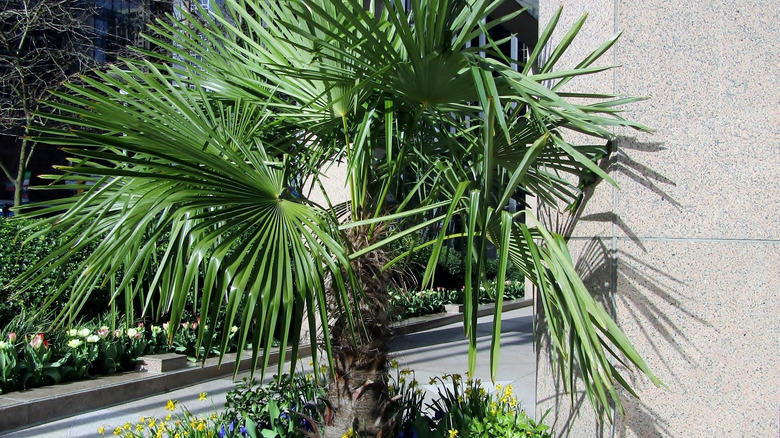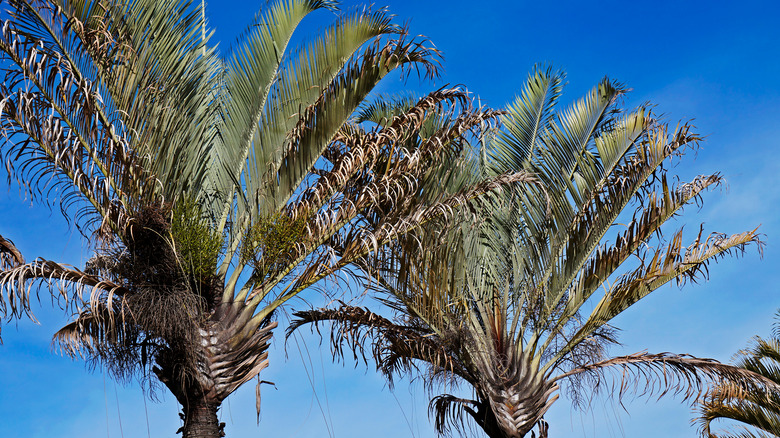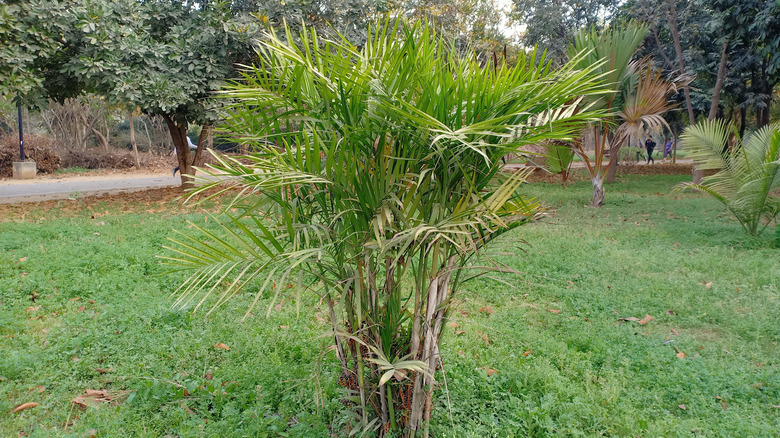15 Types Of Small Palm Trees For Your Garden
Palm trees are often thought of as beach or desert trees, commonly found in cities such as Los Angeles, Miami, and Las Vegas. While people may not give them that much thought, there are over 2,600 different species of palm trees. They come in all different shapes and sizes and can even be grown in your backyard. That's right, if want one in your garden, there are lots of different small palm trees that are the perfect size for your outdoor spaces. The smallest palm tree is about 3 feet tall, so if space is an issue, they can be the perfect solution. Palm trees are also known for their leaves that can be quite big and that stay green all year round, which is great if you are trying to create privacy in your backyard.
Additionally, according to Eat Happy Project, palms are identifiable by their leaves that are divided into two categories: Pinnate (feather-like leaves) and Palmate (fan-like leaves). Before buying a palm or growing one, you'll want to know which category you prefer in order to end up with something you like.
Finally, there are a couple of things to keep in mind before you choose a small palm from our list below. Although all species need different things, most palm trees require a lot of light but no direct sunlight, which is important to remember when you decide where to plant. Also, make sure it has enough room to grow, is very well watered and fed!
1. Pygmy date palms
Quite simple to grow for beginners, the pygmy date palm (Phoenix roebelenii) grows between 6 and 10 feet with sun to partial shade exposure and feather-like leaves that will usually extend about 4 feet in length. This species can be grown indoors or outdoors but as it's from Asia (southern China specifically), it will thrive best in temperatures that do not go below 30 degrees Fahrenheit, as noted by Gardening Know How (although it can maybe handle it if mature enough). Its name derives from the fact it grows yellow-hued flowers followed by purplish dates.
2. Bottle palms
Named for its unique, bottle-shaped trunk, the bottle palm (Hyophorbe lagenicaulis) can be quite the conversation starter. Most bottle palms grow to be 5 to 7 feet tall but can go up to 10 feet after a few years (their growth rate is extremely slow), as per South Florida Plant Guide. Although bottle palms are drought-tolerant, cold is a real threat to them, which is why these types of small palms are usually found in warmer areas. They don't like to be overly wet so planting them in an area where the soil drains well is key.
3. Sago palms
The sago palm (Cycas revolute) will average between 3 and 10 feet tall as well as wide but could take up to 50 years to do so, according to The Spruce. Unlike others in this list, it will not grow flowers, but its nice, green, feather-like foliage grows symmetrically and is pretty nice to look at. This low-growing palm is native to Asia and appreciates a warm and well-lit environment, but can suffer in direct sunlight. This palm is drought tolerant and needs well-draining soil to thrive, so it's important to never overwater it.
4. Spindle palms
The spindle palm (Hyophorbe verschaffeltii), grown in tropical and semi-tropical areas like California, Florida, or Hawaii come to us from the Mascarene Islands in the Indian Ocean. These palms can be both grown outdoors or as a house plant, but its size will vary accordingly. Outdoors, in optimal conditions, this palm can grow up to 25 feet, whereas indoors it will likely not go over 6 feet. Its light gray trunk is where it gets its name, says Plant Care Today, as it is swollen in the middle giving it a spindle shape.
5. Parlor palms
Growing between 10 to 12 feet, the parlor palm (Chamaedorea elegans) is loved by many for its bamboo-like stems. Originally from subtropical and tropical areas, this small palm tree thrives best in medium to bright indirect sunlight. According to The Sill, the general rule of thumb is if the temperature is right for you, it's also right for the parlor palm. It should be watered once to twice a week and repotted two to three times a year. One thing to know is that this type of small palm does grow fruit but it is completely inedible.
6. Pindo palms
The pindo palm (Butia capitate) grows edible berries that can be made into a banana/pineapple flavored jelly. Also called the jelly palm, this type of small palm tree does great in full sunlight and has a high tolerance for droughts, as noted by Planting Tree. It's usually found and best kept in coastline homes as these places have the best climate for its growth. Speaking of growth, this feather-leaf palm can grow up to 20 feet tall and will usually be at least 15.
7. Florida thatch palms
Just like the pygmy date palm, the Florida thatch palm (Thrinax radiate) is not a cold weather tree; it's best kept in weather above 30 degrees. And, although it grows slowly, this palm can be as tall as 20 feet. It can be grown indoors or outdoors, but given its potential height, make sure you have the space if you hope to make it a houseplant. This palm likes a humid climate and All About Palm Trees recommends planting it in moist soil. It also grows a fruit that is round and green and turns white once ripe.
8. Saw palmettos
The saw palmetto (Serenoa repens) is very prominent in Florida, according to Gardening Solutions, as well as highly adaptable and tolerant of all sorts of different climates. This Southeast native palm tree is unique for its multi-trunk characteristic. In fact, the multiple trunks enable it to spread 4 to 10 feet in width. The saw palmetto will typically grow 5 to 10 feet tall. In spring, long stalks grow with small yellow and white flowers that attract bees, creating the famous palmetto honey that Southeastern Americans are so proud of. These flowers also sport small yellow berries that turn black when ripe.
9. Dwarf palmettos
The dwarf palmetto, also known as the sabal minor, is quite unique in that it doesn't have a trunk. Long, fan-like leaves grow to be up to 3 feet long as well as stems (that can be up to 6 feet long) sporting white, strongly scented flowers. The latter then grow round black fruits. If you live in a colder area this might be a good option for you as the dwarf palmetto can survive with no leaf damage in as low as 10-degree weather, according to Gardenia.
10. Dwarf sugar palms
Considered to be one of the most unique small palm trees, the dwarf sugar palm (also called the Arenga palm) is unusual in its growth as it's just as wide as it is tall. In fact, it can be a great alternative for a shrub hedge, suggests the South Florida Plant Guide. However, in sunnier locations, this palm can go up to 15 feet (as opposed to 8 feet in shade) but may lose some of the greenness of its feather-like leaves. This type of palm thrives in a well-draining area as it doesn't like too much moisture.
11. Needle palms
If you're a beginner when it comes to plants, this is a great option: The needle palm (Rhapidophyllum hystrix) is one of the easiest palms to take care of as it adapts to different soil types and climates, as noted by Gardening Know How. It grows needle-like stems (giving it its name) and can reach 6 feet in height and width, so location is key when planting in order for it to have enough space. The leaves also produce red drupes and small flowers that can be white, yellow, brown, or purple.
12. Coontie palms
The coontie palm (Zamia pumila) is once again, easy to maintain and can tolerate different light exposures as well as little water and dry soil. Native to Florida and Georgia, this cold-hardy palm is, per Atlanta Palms, one of the most primitive plants on the planet. This slow and low-growing palm can reach 3 feet in height and can spread almost as much. It works great as an accent plant and can be planted relatively anywhere as it likes both shade and sun and can even withstand freezing weather.
13. Windmill palms
If you want a traditional-looking palm tree on the taller side and have space for it, the windmill palm (Trachycarpus fortune) could be for you. Although the growth rate is slow and can take years, when mature the windmill palm will be between 20 to 40 feet high, therefore coming in at one of the tallest in this list. This palm does, however, need to be watered regularly. And although it is cold-hardy, it thrives best in partial to full sunlight, which means 4 to 6 hours of direct sunlight a day, according to Fast Growing Trees.
14. Triangle palms
Native to Madagascar, the triangle palm (Dypsis decaryi) is quite uniquely shaped in that it has three distinct levels from which the fronds emerge. This beautiful style of palms can be perfect for you if you have a Mediterranean-style garden. The feather-like leaves can grow up to 10 feet long and the tree itself will usually be as tall as 25 to 30 feet. Best kept in well-draining soils and full sunlight, the triangle palm can tolerate cold weather, but Gardenia recommends you don't plant it in an area that dips below 30 degrees.
15. Cat palms
Commonly used as a houseplant, the cat palm (Chamaedorea cataractarum) is the perfect palm to plant in a pot and place in the corner of your living room. This Mexico native should be kept in temperatures between 50 and 80 degrees with medium light as opposed to direct sunlight, according to My Garden Life. Height-wise, this tree will usually grow 5 feet maximum and spread around 3 to 4 feet wide. The cat palm is relatively easy to care for as it just needs to be kept in well-drained soil, watered once a week, and fed once a month.
